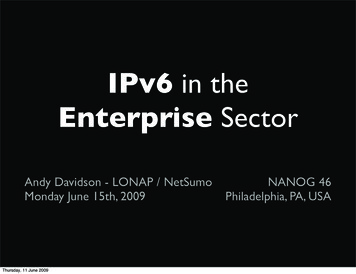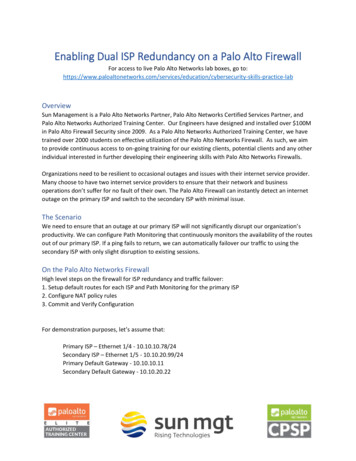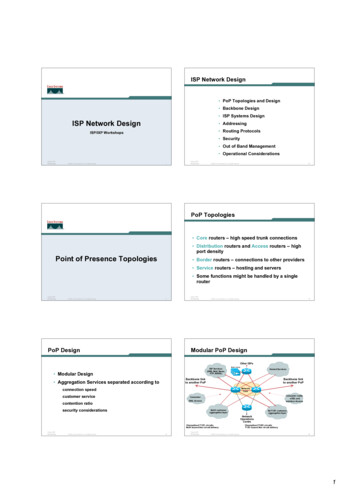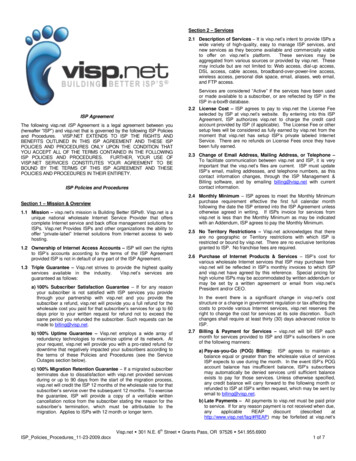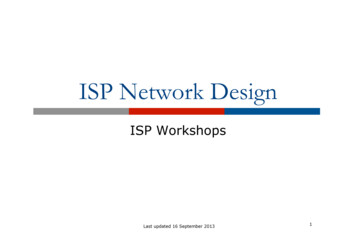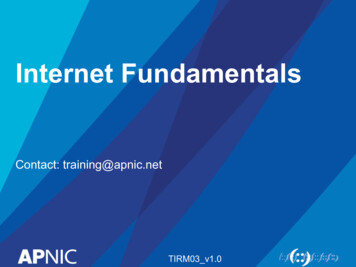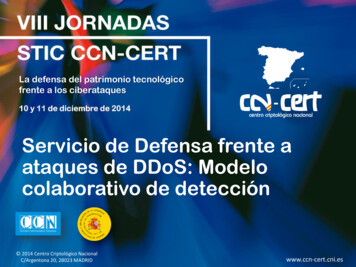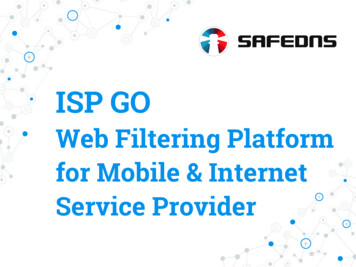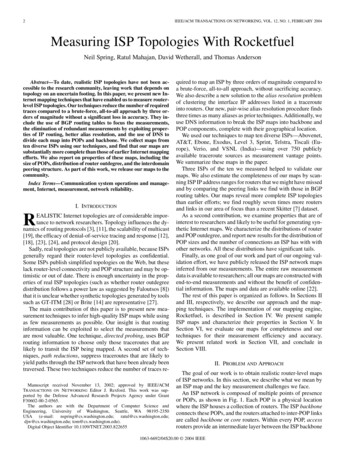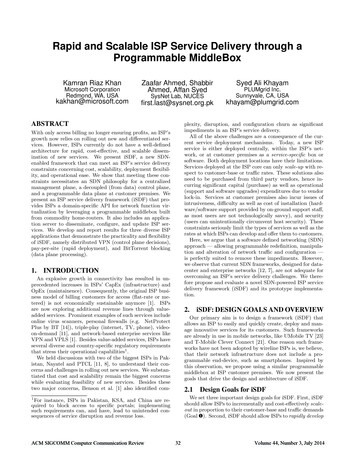
Transcription
Rapid and Scalable ISP Service Delivery through aProgrammable MiddleBoxKamran Riaz KhanMicrosoft CorporationRedmond, WA, USAkakhan@microsoft.comZaafar Ahmed, ShabbirAhmed, Affan SyedSysNet Lab, NUCESPLUMgrid Inc.Sunnyvale, CA, RACTplexity, disruption, and configuration churn as significantimpediments in an ISP’s service delivery.All of the above challenges are a consequence of the current service deployment mechanisms. Today, a new ISPservice is either deployed centrally, within the ISP’s network, or at customer premises as a service-specific box orsoftware. Both deployment locations have their limitations.Services deployed at the ISP core can only scale-up with respect to customer-base or traffic rates. These solutions alsoneed to be purchased from third party vendors, hence incurring significant capital (purchase) as well as operational(support and software upgrades) expenditures due to vendorlock-in. Services at customer premises also incur issues ofintrusiveness, difficulty as well as cost of installation (hardware/software support provided by on-ground support staff,as most users are not technologically savvy), and security(users can unintentionally circumvent host security). Theseconstraints seriously limit the types of services as well as therates at which ISPs can develop and offer them to customers.Here, we argue that a software defined networking (SDN)approach — allowing programmable redefinition, manipulation and alteration of network traffic and configuration —is perfectly suited to remove these impediments. However,we observe that current SDN frameworks, designed for datacenter and enterprise networks [12, 7], are not adequate forovercoming an ISP’s service delivery challenges. We therefore propose and evaluate a novel SDN-powered ISP servicedelivery framework (iSDF) and its prototype implementation.With only access billing no longer ensuring profits, an ISP’sgrowth now relies on rolling out new and differentiated services. However, ISPs currently do not have a well-definedarchitecture for rapid, cost-effective, and scalable dissemination of new services. We present iSDF, a new SDNenabled framework that can meet an ISP’s service deliveryconstraints concerning cost, scalability, deployment flexibility, and operational ease. We show that meeting these constraints necessitates an SDN philosophy for a centralizedmanagement plane, a decoupled (from data) control plane,and a programmable data plane at customer premises. Wepresent an ISP service delivery framework (iSDF) that provides ISPs a domain-specific API for network function virtualization by leveraging a programmable middlebox builtfrom commodity home-routers. It also includes an application server to disseminate, configure, and update ISP services. We develop and report results for three diverse ISPapplications that demonstrate the practicality and flexibilityof iSDF, namely distributed VPN (control plane decisions),pay-per-site (rapid deployment), and BitTorrent blocking(data plane processing).1.Syed Ali KhayamINTRODUCTIONAn explosive growth in connectivity has resulted in unprecedented increases in ISPs’ CapEx (infrastructure) andOpEx (maintainence). Consequently, the original ISP business model of billing customers for access (flat-rate or metered) is not economically sustainable anymore [1]. ISPsare now exploring additional revenue lines through valueadded services. Prominent examples of such services includeonline virus scanners, personal firewalls (e.g. NetProtectPlus by BT [14]), triple-play (internet, TV, phone), videoon-demand [11], and network-based enterprise services likeVPN and VPLS [1]. Besides value-added services, ISPs haveseveral diverse and country-specific regulatory requirementsthat stress their operational capabilities1 .We held discussions with two of the biggest ISPs in Pakistan, Nayatel and PTCL [11, 8], to understand their concerns and challenges in rolling out new services. We substantiated that cost and scalability remain the biggest concernswhile evaluating feasibility of new services. Besides thesetwo major concerns, Benson et al. [1] also identified com-2.Our primary aim is to design a framework (iSDF) thatallows an ISP to easily and quickly create, deploy and manage innovative services for its customers. Such frameworksare already in use in mobile networks, like UMobile TV [23]and T-Mobile Clever Connect [21]. One reason such frameworks have not been adopted by wireline ISPs is, we believe,that their network infrastructure does not include a programmable end-device, such as smartphones. Inspired bythis observation, we propose using a similar programmablemiddlebox at ISP customer premises. We now present thegoals that drive the design and architecture of iSDF.2.1Design Goals for iSDFWe set three important design goals for iSDF. First, iSDFshould allow ISPs to incrementally and cost-effectively scaleout in proportion to their customer-base and traffic demands(Goal ¶). Second, iSDF should allow ISPs to rapidly develop1For instance, ISPs in Pakistan, KSA, and China are required to block access to specific portals; implementingsuch requirements can, and have, lead to unintended consequences of service disruption and revenue loss.ACM SIGCOMM Computer Communication ReviewiSDF: DESIGN GOALS AND OVERVIEW32Volume 44, Number 3, July 2014
ISP Service MgmtTraffic2.3ISP Service ControlTrafficThe iSDF architecture divides the control of flexible ISPservices by employing programmable middlebox functionality at the edge, control plane functionality that can bedistributed, and a centralized management interface for theISP. We next describe components that enable this functionality.ISP CoreServices ManagerInstall, update , revoke services2.3.1ISP ProgrammableMiddle Box ( iProM)ISP ProgrammableMiddle Box ( iProM)Applica!on and ServiceDeliveryApplica!on and ServiceDeliveryMonitoringAbstrac!onApp BControlAbstrac!onForwarding (Data) PlaneCustomer Premises 1App BMonitoringAbstrac!on2.3.2App CControlAbstrac!onForward (Data) PlaneCustomer Premises 22.3.3and deploy new services (Goal ·). Lastly, for widespreadtake-up, iSDF should be operationally simple and hot-pluggable(Goal ). More specifically, pushing new functionality shouldhappen without manual intervention or disruption of existing services.Key Design Decisions for iSDFWith the above design goals in mind, we present a framework (iSDF) to replace the current monolithic and centralized appliances used to introduce ISP services [18]. We firstintroduce our key design decisions to meet the goals identified in Section 2.1. In the next section we elaborate thethree core components that distribute the service logic tocustomer premises (Figure 1).Goal ¶ motivates a distributed model with intelligenceat customer premises, thus decoupling service delivery fromthe implementation at the ISP core. A corollary of this goalis to use commodity hardware to address cost concerns forreal-world deployment of iSDF. The challenge in achievingGoal · is that service use cases differ considerably acrossISPs. Hence, to simultaneously meet the scalability (in traffic processing) and diversity (in use cases) goals, iSDF mustprovide a programmable middlebox at customer premisesfor data plane decisions. We thus propose an SDN-inspiredframework that provides deep programmability of the dataplane (DP) using a domain-specific API. This API is complemented with a service model that also allows the ISP toprogrammatically invoke control plane (CP) decisions acrossdifferent customer premises2 . We meet our third goal (Goal ) by designing a service delivery mechanism that allows forplug-and-play functionality of services at customer premiseswithout disruption to basic connectivity and other services.2ISP Programmable Middlebox (iProM)The core novelty of our proposed framework is a programmable end-device, iProM, at the customer premisesthat iSDF will leverage to deliver, monitor, and implementISP services. This middlebox supports hosting of servicesoffered by the ISP at the application and service deliverylayers. iProM provides the ISP’s IT department with aneasy and programmable platform to monitor the traffic andnetwork setup, essentially allowing for a traditional NOClike view. After discussion with ISP operators, we envisionthat this box will be deployed on the access device providedto customers.2.3.4Monitoring and Control APIOur API provides two high level abstractions. The firstis an API for passively monitoring the data plane using adomain-specific language that allows easy and programmableregistration to application-relevant network events. The second is a set of APIs for controlling the DP, where we proposethat the CP, similar to other SDN models, is made fully programmable. An iSDF service can thus be run entirely in theDP, entirely in the CP (through packet punts), or partlyin control and data planes. This framework provides theservice programmer with flexibility to design an applicationbased on its scalability and visibility requirements.In the API design context, we observe that the monitoringrequired for ISP applications is similar to that required bynetwork intrusion detection systems (NIDS). Thus, from animplementation perspective, we propose reusing an industrystandard NIDS (e.g. [13, 16]) to write new network services.Table 1 provides an overview of our control API thatISP applications can leverage from within service scripts.We have currently divided the API into three broad categories: Traffic filtering (flow blocking), traffic shaping (QoSof flows), and network virtualization. Our current API is,admittedly, restricted and a work-in-progress. Currently itis geared towards enabling the applications that we use forCustomer premises are the basic network unit of an ISP.ACM SIGCOMM Computer Communication ReviewISP servicesA big component of our framework are the ISP serviceswritten over a programmable data-plane (Applications A,B, and C at customer premises in Figure 1). These applications use our monitoring and control APIs to build ISPservices. Optionally, they can have a centralized component(Controller for App B in Figure 1) that allows for correlation and coordination by a controller application over aprogrammable (perhaps using OpenFlow [9]) control-plane.Figure 1: Overview of iSDF showing its three maincomponents.2.2Services ManagerThe Services Manager, residing on the managementplane, acts as a centralized coordinator for installing, configuring, updating, and revoking services. This centralizedlocation at the ISP core shall not be a scalability constraintas we expect a low churn for management operations, perhaps on the order of a single operation per day/customer.Controller for App BApp AiSDF Architectural Components33Volume 44, Number 3, July 2014
CategoryTraffic FilteringExample ApplicationsP2P Blocking, Content censorship, Botnet and DDoS protectionTrafficShapingVideo on demand, VoIP, P2Ptraffic shaping, Pay-per-SiteAPIblock(flow, duration)addClass(classId, bandwidth)NetworkDistributed VPNs, VPLS,Virtualization L2TPremoveClass(classId, bandwidth)addClassMember(classId, flow)removeClassMember(classId, flow)addTunnel(remoteAddress,localAddress, twork, remoteTunnelAddress)CommentsBlock flow for specified duration of seconds.Supports wildcards for flow definition.Defines a new class of traffic which should bethrottled to use specified bandwidth.Undefines an existing class of trafficAdds a flow to a class. All traffic matchingthe flow definition shall be throttled to therespective bandwidth. Supports wildcards forflow definition.Removes a flow from an existing class.Create a tunnel between localAddressand remoteAddress and assign respective*tunnelAddresses.Route data for network to remoteTunnelAddress.Table 1: iSDF API for a programmable data plane (at customer premises) and an optional control plane atservice-specific controller. Data plane monitoring uses the comprehensive Bro language API.server (conceptually anywhere on the Internet) as two-hop,L3-accessible machines for the iProM.Customer PremisesISP & Wider InternetServices ManagerServer3.2ap Getp.tar.gzInternetEthernetLaptopL3 ConnectivityRouterSpeed TestServeriProM - Mikrotik Ethernet750glComputerFigure 2: Our iSDF prototype emulating customerpremises with access to ISP core and Internet.evaluation in Section 4, but it is meant to demonstrate theflexibility of our programmable data-plane. We provide implementation details for this API in Section 3.3.iSDF IMPLEMENTATIONWe now discuss and evaluate our prototype implementation of the iSDF framework. This new prototype of a SDNpowered ISP service delivery framework comprises three parts:a network setup emulating ISP-customer connectivity, theservice delivery mechanism, and implementation of the dataplane monitoring and control API.3.1Operational Setup of iSDF PrototypeWe begin by describing the network setup we employ toemulate ISP-customer connectivity (Figure 2). We implement iSDF over this network setup to evaluate the deliveryof ISP services using our framework.Our operational vision of the service delivery system relies on developing a low-cost, active, and flexible middleboxat customer premises. We therefore implement iProM on acommodity home-router (Mikrotik 750gl router with 64MBRAM @ 400Mhz) for a low-cost solution. We choose OpenWRT platform as it allows us to leverage the large base ofopen-source Linux tools; it thus facilitates an iProM devicethat provides expressive and flexible monitoring as well asactive control of network traffic and configurations.We emulate access to the ISP core and wider Internetusing an L3 router. We locally host both the Services Manager (conceptually at the ISP) and any application-specificACM SIGCOMM Computer Communication ReviewData Plane Monitoring and ControlIn our implementation of iProM, we choose the Bro programming language to provide an expressive and powerfullayer to monitor the data plane [13]. Bro, while initiallyintended for network intrusion detection, has evolved toprovide very efficient, event-based monitoring of networktraffic. Furthermore, Bro filters network events such thatits processing requirement is proportional to the depth ofpacket inspection, thus allowing us to scale with application needs by using a more powerful (and costly) middlebox.The choice for using Bro is made easier owing to an activeBro community that allows our monitoring framework toremain updated. To enable this choice, we ported Bro toOpenWRT3 .ISP services therefore are Bro scripts written by the service developer. We provide three different categories of control API (Table 1), within the Bro framework, that a developer can use to control aspects of network traffic andconfigurations. We believe that the expressive language ofBro and our control API will together allow developers toquickly build novel network services.We provide a single function for the Traffic Filteringcategory. This function is implemented using iptables andrequires the Bro-specific connection structure for representing a flow as a 5-tuple, and generates a filtering rule forthis flow. We also generate an “anti-rule” that rescinds theoriginal rule and is executed after the duration specified.We believe that our implementation of flow definition, withwildcards, is sufficient for most ISP applications. However,this is not a constraint on the framework, and flow definitions can be enhanced using other tools more sophisticatedthan iptables.For Traffic Throttling we provide functions for managing different traffic classes. Our API creates classful queuingdisciplines (qdisc) via the tc utility, with each class assigneda specific bandwidth. We use the iptables firewall to categorize each flow, defined by a 5-tuple, into a particularclass. The kernel queuing mechanism then restricts eachflow to the bandwidth specified for its class. Our API provides a way to not only remove differentiated flows from aclass (policy-based) but also traffic classes themselves (service removal).3For details of port and all applications developed in Section 4 visit: sysnet.org.pk/w/ISDF34Volume 44, Number 3, July 2014
The final category for Network Virtualization providesan API to build L3 tunnels and correspondingly add routeson the iProM devices. We use the iproute2 package forbuilding a GRE tunnel interface between specified endpoints.We then bring up this interface, setup a routing rule to theremote tunnel subnet, and use iptables to add a firewall ruleallowing forwarding on the new tunnel interface. We expectto expand our API in this section to allow L2 virtualization(using for example, VPLS or L2TP).We also implement simple heuristics (similar to work byFerguson et al. [4]) to identify conflicts between iProM rulesregarding traffic classes and network virtualization, thus simplifying the job of a service developer.3.3as part of a code by. This API-constrained code (and notsimple flow-rules) can now be pushed by the iSDF controlplane to our middlebox, allowing for a flexible and simplepath to service deployment. Thus our framework enablesapplication writers to decide their split of application functionality between the data and control planes.4.We now evaluate our prototype implementation (Figure 2),along three axes (programming ease, deployment flexibility,and performance overhead) using three diverse use-cases.These use-cases are by no means exhaustive; in fact, webelieve that our programmable platform will enable implementation of novel and innovative applications.Service Delivery Mechanism4.1We need a robust and scalable service delivery platformwith minimal overhead and the ability to hot-plug (install)and hot-swap (update) applications. For this purpose, weemploy a hybrid push/pull model for service delivery. TheiProM periodically (default 30 minutes) pulls applicationsfrom an ISP-specified, customer-specific URL. These application are downloaded as a tarball containing the application scripts along with their respective MD5 hashes. Thesescripts are executed immediately on success of a uniquenesscheck performed by comparing with previous hash. We envision that ISPs will digitally sign these scripts to ensureservice integrity. We augment this pull mechanism with anasynchronous push that the ISP services manager can execute by sending a connection attempt on a port where iProMis listening. Once a connection is established at this port,the iProM simply repeats the pull process described above.While we currently have a proprietary implementation topush services, looking into using package managers presentin OpenWRT is a future work we will explore.3.4DiscussionHere we discuss our reason for choosing a custom SDNimplementation, forgoing the benefit of using a standardized implementation like OpenFlow [9]. While OpenFlowis one possible option, we see two constraints that renderOpenFlow inappropriate for implementing iSDF.Scalability: A fundamental design objective of iSDF is toallow operators to roll out new services at scale. With an increasing ISP customer base, scalability can be achieved onlyby pushing as much packet processing functionality to thedata plane as possible, and only forwarding the absolutelynecessary information to the control plane (CP). OpenFlowarchitecture, however cannot support such an implementation, as it requires the main packet processing applicationto run in the CP, while a simple match, action packetprocessing engine operates in the DP.Programmability: Application use cases will vary considerably across different ISPs and target demographics. Theseapplications require different types of L2 to L7 packet processors and programs that could control these packet processors to come up with the requisite metrics.4 To achievethis level of programmability with OpenFlow, iSDF wouldagain have to forward every packet to the CP. We insteadchose to provide a contained set of ISP-specific data-planeAPIs (admittedly limited at this point) that can be invoked4For instance, detecting that a particular URL is present inan HTTP query, or finding that a particular application iscommunicating on an abnormal number of unique ports.ACM SIGCOMM Computer Communication ReviewEVALUATING OUR iSDF PROTOTYPE35Programmability: Distributed VPNOur first application implements the enterprise VPN service described by Benson et al. [1], to demonstrate the easein developing services, having even the optional control planecomponent, using iSDF. Our implementation of this servicehas two novel facets. First, our distributed implementationat enterprise end-points decouples tunnel creation from bothvendor hardware and implementation of the ISP core. Thisdecoupling simplifies management and allows ISPs to incrementally scale out, in contrast with current solutions thatare expensive, difficult to configure, and vendor-locked [1]. Asecond novelty is the automation of tunnel creation by usinga control plane decision triggered for every new site. Thus,for enterprise sites running this service, a bootstrap portionprovides credentials to a central service-specific server (AppB in Figure 1). This central server, after validating credentials, treats every connection as a new virtual link comingup, and makes a control-plane decision to set up a virtual L3network between clients that match the enterprise VPN policy (hub/spoke, mesh). Our applications at each endpointthen establish tunnels and routes for the new site.We have implemented this powerful and complex serviceusing just 74 lines of code (31 lines of Bro script and 43lines of php at the central server) in our iSDF prototypeimplementation. This clearly demonstrates the potential ofour framework for improving existing services as well as forlowering cost and implementation complexity for ISPs.4.2Rapid Deployment of Services:Pay-per-Site PackagesOur next application is inspired by mobile ISP operatorsproviding differentiated and site-specific access to their users(e.g. unlimited access to TV streams [23]), with an aimto show rapid deployment of a new service through iSDF.We demonstrate the installation and application of such a“pay-per-site” service by hosting two servers on our emulated Internet. The ISP services manager provisions for thisapplication in the ISP core and subsequently pushes a newservice that, using our API, renders appropriate bandwidthfor the selected destination. This service is implemented iniSDF using just 25 lines of code. As comparison, PTCL andNayatel currently employ Juniper SRC solution, for approximately half-million USD, to provide similar services [18].For performance evaluation, we downloaded 600 MB filesfrom two different mirrors (denoted as mirrors A and B ).The bandwidth is throttled to 150kBps on the Internet connection. As shown in Figure 3, initially both downloadsequally share the 150kBps base bandwidth; at 200s the cus-Volume 44, Number 3, July 2014
Mirror AMirror Btions) makes implementation of this service infeasible at theISP core. This service aims to demonstrate a data-plane intensive application that cannot be implemented at the coreand to bound the impact that iProM, like any middlebox,has on performance.We evaluate this service, running on an iProM, as twolocal computers download torrents from the Internet. Simultaneously, we perform speed tests from a local server(shown in Figure 2). We use our traffic filtering API toblock identified BitTorrent flows for a policy-specific time.Figure 4 shows that while memory consumption increaseson our iProM, it stays within the 64Mb RAM common forlow-cost home routers. We notice that since CPU usagedecreases, the observed throughput decrease is due to perpacket inspection that increases forwarding latency. However, the resulting throughput decrease of about 16% is itselfacceptable for such an intensive middlebox application.300iProM150HTTP/OK200http : GETService Managerudp src [9009]Throughput (kBps )250udp dst [9009]Policy DownloadPush100500050100150200250300350400Time ( Seconds )Figure 3: At 200s a customer selects our Pay-perSite service (for mirror A) to get higher bandwidthas iSDF installs a new 140501201004080306020Throughput ( Mbit/s )Usage of CPU and Memory on iProM ( % )5.40102000iSDFWithout-iSDFFigure 4: Impact of running a data plane intensiveapplication detecting BitTorrent flows.tomer purchases (out-of-band) the service for upgrading hisbandwidth for mirror A. The ISP services manager, havingvalidated the payment, installs the service using the pushmechanism described in Section 3.3 (inset in Figure 3). Withuser-imperceptible delay, iProM upgrades the bandwidth to200kBps for the flow to mirror A while the flow to mirror Bstarts utilizing the full base bandwidth of 150kBps.4.3Performance Overhead: Torrent BlockingOur final application is the detection and blocking (orshaping) of BitTorrent flows, using custom protocol analyzers that predict BitTorrent connections (including failedTCP handshakes) by analyzing peer-coordination traffic (trackers, DHT, PEX) [6]. Since this application requires detailedpacket analysis with no correlation across multiple iProMdevices, it is architecturally well-suited to be implementedcompletely in the data plane. Furthermore by requiring processing of all packets – the depth of inspection varying basedon headers – this application represents the worst-case processing overhead for an iSDF application. Similarly, thecost of maintaining state (for possible BitTorrent connec-ACM SIGCOMM Computer Communication Review36RELATED WORKBenson et al. [1] analyze several years’ worth of configuration data on a tier-1 ISP and conclude that device configuration complexity, which grows with time, is a majorbottleneck in ISP service deployment. iSDF aims to resolvethis by equipping ISPs with a scalable mechanism to rollout services using a programmable middlebox at customerpremises.Project BISmark and Project Homework have both developed SDN-inspired home/SOHO based solutions for ISPcustomers [2, 20, 19, 22]. While most of these involve passivemonitoring and collection of information for applications likenetwork troubleshooting and net-neutrality observation [2,20], a small subset has looked at active manipulation to allow users to manage bandwidth caps per device and improveintrusion detection [3, 10]. All these works are complementary to ours as they target end-user products but have nointeraction with the ISP.Recent research has been directed at managing and configuring middlebox deployments using SDN techniques; SIMPLE and OpenMB are two examples [15, 5]. The focusof these work remains in providing greater reliability andsimplifying the management for (re)configuration of middleboxes. Our work focuses on a identifying a specific location for middleboxes that provides a mechanism to deliverISP-specific services at customer premises. However, thesemiddlebox management frameworks can (in parallel) be usedfor load-balancing and failure recovery of iProM at SOHOcustomer premises.Finally, the idea behind Netcalls presents a simplified APIto logically abstract network services for clients [17]. Thiswork is from the perspective of clients, with services beingimplemented inside the network, by either the clients’ homeISP or a peering ISP, with service resolution performed bythe home ISP. In contrast we scalably implement networkservices at the customer premises using our programmablemiddlebox.6.CONCLUSIONS AND FUTURE WORKIn this paper we propose a distributed ISP service deliveryframework (iSDF) that decouples ISP services from its coreallowing portable, cost-effective, flexible, and easy management of ISP services across different hardware vendors andISP core configurations. As future work, we plan to workVolume 44, Number 3, July 2014
closely with ISPs to enrich our API for greater conveniencein developing ISP services. In addition, we aim to incorporate security measures in the service delivery mechanism toprevent exploitation of the push/pull mechanism for DDoSing the Services Manager. Similarly, the authenticity of theservice payloads shall be verified using a public-key signature scheme, or by employing the existing package management systems provided in Linux/OpenWRT. We also wantto explore a more refined application delivery system, inspired by the app store model, for customers to use finegrained (in time) services through micro transactions. Weare currently interacting with several ISPs to deploy ourframework and get experimental results over a productionnetwork.[9] Nick McKeown, Tom Anderson, Hari Balakrishnan,Guru Parulkar, Larry Peterson, Jennifer Rexford,Scott Shenker, and Jonathan Turner. Openflow:enabling innovation in campus networks. SIGCOMMComput. Commun. Rev., 38(2):69–74, March 2008.[10] Syed Akbar Mehdi, Junaid Khalid, and Syed AliKhayam. Revisiting traffic anomaly detection usingsoftware defined networking. In Proceedings of RAID,RAID’11, pages 161–180, Berlin, Heidelberg, 2011.Springer-Verlag.[11] Nayatel. www.nayatel.pk.[12] Radhika Niranjan Mysore, Andreas Pamboris, NathanFarrington, Nelson Huang, Pardis Miri, SivasankarRadhakrishnan, Vikram Subramanya, and AminVahdat. Portland: a scalable fault-tolerant layer 2data center network fabric. In Proceedings of the ACMSIGCOMM 2009 conference on Data communication,SIGCOMM ’09, pages 39–50, New York, NY, USA,2009. ACM.[13] Vern Paxson. Bro: a system for detecting networkintruders in real-time. In Proceedings of the 7thconference on USENIX Security Symposium - Volume7, SSYM’98, pages 3–3, Berkeley, CA, USA, 1998.USENIX Association.[14] BT NetProtect Plus. http://bit.ly/156F5yV.[15] Zafar Ayyub Qazi, Cheng-Chun Tu, Luis Chiang, RuiMiao, Vyas Sekar, and Minlan Yu. Simple-fyingmiddlebox policy enforcement using sdn. InProceedings of the ACM SIGCOMM 2013 Conference,SIGCOMM ’13, pages 27–38, New York, NY, USA,2013. ACM.[16] M. Roesch. Snort - lightweight in
o ered by the ISP at the application and service delivery layers. iProM provides the ISP's IT department with an easy and programmable platform to monitor the tra c and network setup, essentially allowing for a traditional NOC-like view. After discussion with ISP operators, we envision that this box will be deployed on the access device provided
